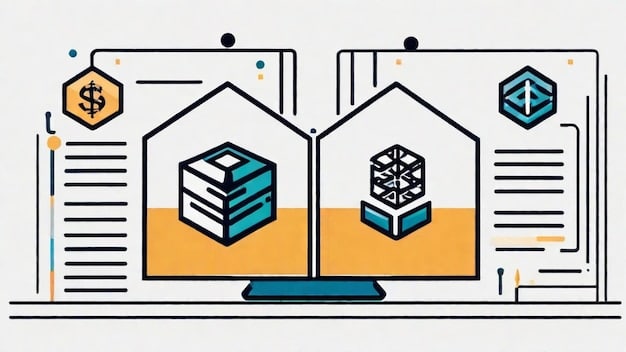Optimizing Ethereum L2 Gas Fees: A 2025 Guide for US Web3 Developers

Optimizing gas fees on Ethereum Layer-2 solutions in early 2025 is crucial for US-based Web3 developers aiming to build cost-effective and scalable decentralized applications, necessitating a thorough comparison of available L2 technologies and their respective fee structures.
Navigating the world of Ethereum Layer-2 solutions can be daunting, especially when considering the ever-present issue of gas fees. For US-based Web3 developers looking to build efficient and scalable decentralized applications in early 2025, understanding how to optimize these fees is paramount. This article provides a comprehensive comparison of different Layer-2 solutions, offering insights into their gas fee structures and strategies for minimization, empowering developers to make informed decisions and build cost-effective applications. Let’s delve into the world of optimizing gas fees on Ethereum Layer-2 solutions: a comparison for US-based Web3 developers in early 2025.
Understanding Ethereum Gas Fees: A Quick Recap
Before diving into Layer-2 solutions, it’s essential to understand the basics of Ethereum gas fees. These fees are the transaction costs required to execute operations on the Ethereum blockchain.
What are Gas Fees?
Gas fees compensate miners (or validators in a Proof-of-Stake system) for the computational effort required to process transactions and maintain the network’s security. These fees are paid in ETH, Ethereum’s native cryptocurrency.
The price of gas fluctuates based on network congestion. High demand leads to higher gas prices, making transactions more expensive. This can significantly impact the cost of interacting with decentralized applications (dApps) on Ethereum.

Why are Gas Fees a Problem?
High gas fees can hinder the adoption of dApps, especially for users engaging in frequent or small-value transactions. This is where Layer-2 solutions come in. They aim to reduce gas costs by processing transactions off the main Ethereum chain.
- Accessibility: High fees make dApps inaccessible to many users.
- Scalability: Ethereum’s limited transaction throughput is exacerbated by high gas fees.
- User Experience: Cumbersome and expensive transactions create a poor user experience.
In summary, gas fees are a critical factor affecting Ethereum’s usability and scalability, driving the need for efficient Layer-2 solutions to mitigate these problems.
An Overview of Ethereum Layer-2 Solutions
Layer-2 solutions address Ethereum’s scalability and gas fee issues by processing transactions off the main chain while still benefiting from Ethereum’s security.
These solutions work by bundling multiple transactions into a single batch or executing them on a separate chain that periodically reports to the main Ethereum chain, reducing the load and associated costs.
Types of Layer-2 Solutions
There are different types of Layer-2 solutions, each with its own approach to reducing gas fees and improving transaction throughput. Two popular categories are rollups and validium chains.
- Rollups: These execute transactions off-chain and post transaction data to the Ethereum main chain, providing strong security.
- Validium Chains: Similar to rollups, but data availability is managed off-chain, typically offering lower fees but potentially lower security.
- State Channels: Allow participants to transact multiple times off-chain and only submit the final state to the main chain.
The choice of Layer-2 solution depends on the specific requirements of the dApp, including security needs, transaction volume, and acceptable latency.

How Layer-2 Solutions Reduce Gas Fees
Layer-2 solutions reduce gas fees by minimizing the amount of data and computation required on the Ethereum main chain. By processing transactions off-chain and only submitting summarized data or proofs, they significantly decrease the cost per transaction.
This reduction in gas fees makes Ethereum more accessible and scalable, paving the way for wider adoption and more complex decentralized applications.
Comparing Popular Layer-2 Solutions for Gas Fee Optimization
Several Layer-2 solutions are vying for prominence in the Ethereum ecosystem. Let’s compare some of the most popular options based on gas fee optimization:
Optimistic Rollups: Optimism and Arbitrum
Optimistic rollups assume all transactions are valid unless proven otherwise. This optimistic approach reduces computational overhead, resulting in lower gas fees.
Optimism: A popular Optimistic Rollup focused on simplicity and EVM compatibility. Transactions are bundled and submitted to the main chain with a fraud-proof mechanism to ensure validity.
zk-Rollups: StarkNet and zkSync
Zero-knowledge rollups (zk-Rollups) use cryptographic proofs to validate transactions off-chain, offering even greater scalability and lower gas fees.
StarkNet: A permissionless decentralized ZK-Rollup operating over Ethereum. Uses STARK proofs for scalability and security.
Validium Chains: Immutable X
Validium chains are another type of Layer-2 scaling solution, similar to ZK-rollups, but they store data availability off-chain.
Immutable X: Built specifically for NFTs, Immutable X offers instant transaction confirmation and zero gas fees for trading. Uses StarkWare’s StarkEx technology.
Gas fees vary based on transaction complexity and network congestion, but Layer-2 solutions generally offer significant savings compared to transacting directly on Ethereum’s main chain.
Gas Fee Structures and Transaction Costs on Each Solution
Understanding the gas fee structure of each Layer-2 solution is crucial for US-based Web3 developers. Let’s break down the transaction costs associated with each platform:
Optimism: Fee Calculation and Optimization
Optimism’s gas fee structure involves two main components: L1 data posting cost and L2 execution cost. The L1 data posting cost represents the expense of submitting transaction data to the Ethereum main chain.
Arbitrum: Fee Calculation and Optimization
Arbitrum employs a similar two-tiered gas fee structure, with costs for data posting to L1 and execution on L2. Transaction fees depend on the computational resources consumed on the Arbitrum chain and the current gas price on Ethereum.
Estimating gas fees accurately is crucial for optimizing costs. Developers can use tools to predict gas prices and adjust transaction parameters accordingly.
- Gas Limit: Setting an appropriate gas limit can prevent unnecessary fees.
- Transaction Bundling: Batching multiple transactions can reduce overall costs.
- Off-Peak Hours: Executing transactions during off-peak hours can lower gas prices.
By understanding these factors and employing appropriate strategies, developers can significantly reduce gas fees on Layer-2 solutions like Optimism and Arbitrum.
Strategies for Minimizing Gas Fees on Layer-2
Optimizing gas fees is vital for creating cost-effective dApps on Layer-2 solutions. Here are some key strategies for US-based Web3 developers to consider:
Batching Transactions
Batching involves grouping multiple transactions into a single transaction, reducing the overall gas cost. This is particularly effective for applications with frequent, small transactions.
Smart contracts can be designed to support batching functionality, allowing users to submit multiple operations in a single transaction, significantly reducing gas fees.
Using Gas Tokens
Gas tokens are tokens that can be used to offset gas costs by exploiting Ethereum’s storage refund mechanism. When storage is cleared, a refund is issued, effectively reducing the net gas expenditure.
Gas tokens can be used to reduce gas consumption during periods of high network congestion, providing significant cost savings for dApp users.
- Storage Optimization: Optimize smart contract storage to minimize gas costs.
- Efficient Data Structures: Use efficient data structures to reduce gas consumption.
- Code Audits: Conduct thorough code audits to identify and eliminate gas inefficiencies.
By implementing these strategies, developers can minimize gas fees and create more accessible and cost-effective dApps on Ethereum Layer-2 solutions.
Future Trends and Developments in Layer-2 Gas Fee Optimization
The Ethereum Layer-2 landscape is constantly evolving, with ongoing research and development efforts aimed at further reducing gas fees and improving scalability. Let’s explore some future trends and developments in this space:
EIP-4844: Proto-Danksharding
EIP-4844, also known as Proto-Danksharding, is a proposed Ethereum Improvement Proposal that aims to introduce a new transaction type that carries “blobs” of data. These blobs are cheaper than calldata, which is currently used by Layer-2 solutions to post transaction data to the main chain.
Proto-Danksharding is expected to significantly reduce gas fees for Layer-2 solutions, making them even more competitive.
Data Compression Techniques
Researchers are exploring advanced data compression techniques to further reduce the amount of data that needs to be posted to the Ethereum main chain. By compressing transaction data, Layer-2 solutions can lower their gas costs and improve scalability.
Data compression techniques, combined with other optimizations, hold the promise of dramatically reducing gas fees on Layer-2 solutions in the near future.
- Dynamic Fees: Implementing dynamic fee mechanisms can optimize gas usage.
- Cross-Layer-2 Communication: Improve interoperability between different Layer-2 solutions.
- Enhanced Security: Continuously enhance security measures to protect against potential vulnerabilities.
These ongoing developments in Layer-2 gas fee optimization will pave the way for a more scalable, accessible, and user-friendly Ethereum ecosystem.
| Key Point | Brief Description |
|---|---|
| 💡 L2 Solutions | Reduce Ethereum gas fees by processing transactions off-chain. |
| ⚡ Optimistic Rollups | Like Optimism and Arbitrum assume transactions valid unless proven otherwise, lowering computational costs. |
| 🔒 zk-Rollups | Such as StarkNet and zkSync, use cryptographic proofs to validate transactions off-chain. |
| 💰 Gas Optimization | Includes batching, gas tokens, and efficient smart contract design for cost reduction. |
FAQ
▼
Layer-2 solutions are technologies built on top of Ethereum that aim to improve transaction speed and reduce gas fees by processing transactions off the main Ethereum chain. These solutions help alleviate congestion and make Ethereum more scalable.
▼
Optimistic Rollups reduce gas fees by assuming that transactions are valid unless proven otherwise. This approach minimizes the computational overhead required on the main chain, leading to lower gas costs for users.
▼
zk-Rollups use zero-knowledge proofs to validate transactions off-chain. This means that transaction validity can be proven without revealing the transaction data itself, resulting in high scalability and reduced gas fees.
▼
EIP-4844, or Proto-Danksharding, introduces a new transaction type with “blobs” for data, cheaper than calldata. This significantly reduces gas fees for Layer-2 solutions posting data to the main chain, boosting scalability.
▼
Developers can minimize gas fees by batching transactions, using gas tokens, and optimizing smart contract code for efficiency. These strategies reduce the amount of gas consumed per operation, leading to lower overall costs.
Conclusion
In conclusion, optimizing gas fees on Ethereum Layer-2 solutions is essential for US-based Web3 developers in early 2025. By understanding the different Layer-2 options available, employing effective gas minimization strategies, and staying informed about future developments, developers can build cost-effective and scalable decentralized applications that drive innovation and adoption in the Web3 space.





